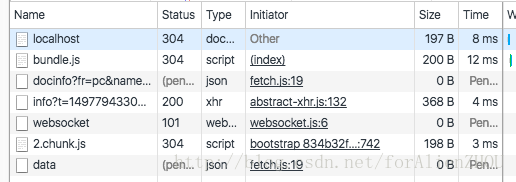您好,登录后才能下订单哦!
前言
随着前端项目的不断扩大,一个原本简单的网页应用所引用的js文件可能变得越来越庞大。尤其在近期流行的单页面应用中,越来越依赖一些打包工具(例如webpack),通过这些打包工具将需要处理、相互依赖的模块直接打包成一个单独的bundle文件,在页面第一次载入时,就会将所有的js全部载入。但是,往往有许多的场景,我们并不需要在一次性将单页应用的全部依赖都载下来。例如:我们现在有一个带有权限的"订单后台管理"单页应用,普通管理员只能进入"订单管理"部分,而超级用户则可以进行"系统管理";或者,我们有一个庞大的单页应用,用户在第一次打开页面时,需要等待较长时间加载无关资源。这些时候,我们就可以考虑进行一定的代码拆分(code splitting)。
实现方式
简单的按需加载
代码拆分的核心目的,就是实现资源的按需加载。考虑这么一个场景,在我们的网站中,右下角有一个类似聊天框的组件,当我们点击圆形按钮时,页面展示聊天组件。
btn.addEventListener('click', function(e) {
// 在这里加载chat组件相关资源 chat.js
});
从这个例子中我们可以看出,通过将加载chat.js的操作绑定在btn点击事件上,可以实现点击聊天按钮后聊天组件的按需加载。而要动态加载js资源的方式也非常简单(方式类似熟悉的jsonp)。通过动态在页面中添加<scrpt>标签,并将src属性指向该资源即可。
btn.addEventListener('click', function(e) {
// 在这里加载chat组件相关资源 chat.js
var ele = document.createElement('script');
ele.setAttribute('src','/static/chat.js');
document.getElementsByTagName('head')[0].appendChild(ele);
});
代码拆分就是为了要实现按需加载所做的工作。想象一下,我们使用打包工具,将所有的js全部打包到了bundle.js这个文件,这种情况下是没有办法做到上面所述的按需加载的,因此,我们需要讲按需加载的代码在打包的过程中拆分出来,这就是代码拆分。那么,对于这些资源,我们需要手动拆分么?当然不是,还是要借助打包工具。下面就来介绍webpack中的代码拆分。
代码拆分
这里回到应用场景,介绍如何在webpack中进行代码拆分。在webpack有多种方式来实现构建是的代码拆分。
import()
这里的import不同于模块引入时的import,可以理解为一个动态加载的模块的函数(function-like),传入其中的参数就是相应的模块。例如对于原有的模块引入import react from 'react'可以写为import('react')。但是需要注意的是,import()会返回一个Promise对象。因此,可以通过如下方式使用:
btn.addEventListener('click', e => {
// 在这里加载chat组件相关资源 chat.js
import('/components/chart').then(mod => {
someOperate(mod);
});
});
可以看到,使用方式非常简单,和平时我们使用的Promise并没有区别。当然,也可以再加入一些异常处理:
btn.addEventListener('click', e => {
import('/components/chart').then(mod => {
someOperate(mod);
}).catch(err => {
console.log('failed');
});
});
当然,由于import()会返回一个Promise对象,因此要注意一些兼容性问题。解决这个问题也不困难,可以使用一些Promise的polyfill来实现兼容。可以看到,动态import()的方式不论在语意上还是语法使用上都是比较清晰简洁的。
require.ensure()
在webpack 2的官网上写了这么一句话:
require.ensure() is specific to webpack and superseded by import().
所以,在webpack 2里面应该是不建议使用require.ensure()这个方法的。但是目前该方法仍然有效,所以可以简单介绍一下。包括在webpack 1中也是可以使用。下面是require.ensure()的语法:
require.ensure()接受三个参数:
因此,require.ensure()具体的用法如下:
btn.addEventListener('click', e => {
require.ensure([], require => {
let chat = require('/components/chart');
someOperate(chat);
}, error => {
console.log('failed');
}, 'mychat');
});
Bundle Loader
除了使用上述两种方法,还可以使用webpack的一些组件。例如使用Bundle Loader:
npm i --save bundle-loader
使用require("bundle-loader!./file.js")来进行相应chunk的加载。该方法会返回一个function,这个function接受一个回调函数作为参数。
let chatChunk = require("bundle-loader?lazy!./components/chat");
chatChunk(function(file) {
someOperate(file);
});
和其他loader类似,Bundle Loader也需要在webpack的配置文件中进行相应配置。Bundle-Loader的代码也很简短,如果阅读一下可以发现,其实际上也是使用require.ensure()来实现的,通过给Bundle-Loader返回的函数中传入相应的模块处理回调函数即可在require.ensure()的中处理,代码最后也列出了相应的输出格式:
/*
Output format:
var cbs = [],
data;
module.exports = function(cb) {
if(cbs) cbs.push(cb);
else cb(data);
}
require.ensure([], function(require) {
data = require("xxx");
var callbacks = cbs;
cbs = null;
for(var i = 0, l = callbacks.length; i < l; i++) {
callbacks[i](data);
}
});
*/
react-router v4 中的代码拆分
最后,回到实际的工作中,基于webpack,在react-router4中实现代码拆分。react-router 4相较于react-router 3有了较大的变动。其中,在代码拆分方面,react-router 4的使用方式也与react-router 3有了较大的差别。
在react-router 3中,可以使用Route组件中getComponent这个API来进行代码拆分。getComponent是异步的,只有在路由匹配时才会调用。但是,在react-router 4中并没有找到这个API,那么如何来进行代码拆分呢?
在react-router 4官网上有一个代码拆分的例子。其中,应用了Bundle Loader来进行按需加载与动态引入
import loadSomething from 'bundle-loader?lazy!./Something'
然而,在项目中使用类似的方式后,出现了这样的警告:
Unexpected '!' in 'bundle-loader?lazy!./component/chat'. Do not use import syntax to configure webpack loaders import/no-webpack-loader-syntax
Search for the keywords to learn more about each error.
在webpack 2中已经不能使用import这样的方式来引入loader了(no-webpack-loader-syntax)
Webpack allows specifying the loaders to use in the import source string using a special syntax like this:
var moduleWithOneLoader = require("my-loader!./my-awesome-module");
This syntax is non-standard, so it couples the code to Webpack. The recommended way to specify Webpack loader configuration is in a Webpack configuration file.
我的应用使用了create-react-app作为脚手架,屏蔽了webpack的一些配置。当然,也可以通过运行npm run eject使其暴露webpack等配置文件。然而,是否可以用其他方法呢?当然。
这里就可以使用之前说到的两种方式来处理:import()或require.ensure()。
和官方实例类似,我们首先需要一个异步加载的包装组件Bundle。Bundle的主要功能就是接收一个组件异步加载的方法,并返回相应的react组件:
export default class Bundle extends Component {
constructor(props) {
super(props);
this.state = {
mod: null
};
}
componentWillMount() {
this.load(this.props)
}
componentWillReceiveProps(nextProps) {
if (nextProps.load !== this.props.load) {
this.load(nextProps)
}
}
load(props) {
this.setState({
mod: null
});
props.load((mod) => {
this.setState({
mod: mod.default ? mod.default : mod
});
});
}
render() {
return this.state.mod ? this.props.children(this.state.mod) : null;
}
}
在原有的例子中,通过Bundle Loader来引入模块:
import loadSomething from 'bundle-loader?lazy!./About'
const About = (props) => (
<Bundle load={loadAbout}>
{(About) => <About {...props}/>}
</Bundle>
)
由于不再使用Bundle Loader,我们可以使用import()对该段代码进行改写:
const Chat = (props) => (
<Bundle load={() => import('./component/chat')}>
{(Chat) => <Chat {...props}/>}
</Bundle>
);
需要注意的是,由于import()会返回一个Promise对象,因此Bundle组件中的代码也需要相应进行调整
export default class Bundle extends Component {
constructor(props) {
super(props);
this.state = {
mod: null
};
}
componentWillMount() {
this.load(this.props)
}
componentWillReceiveProps(nextProps) {
if (nextProps.load !== this.props.load) {
this.load(nextProps)
}
}
load(props) {
this.setState({
mod: null
});
//注意这里,使用Promise对象; mod.default导出默认
props.load().then((mod) => {
this.setState({
mod: mod.default ? mod.default : mod
});
});
}
render() {
return this.state.mod ? this.props.children(this.state.mod) : null;
}
}
路由部分没有变化
<Route path="/chat" component={Chat}/>
这时候,执行npm run start,可以看到在载入最初的页面时加载的资源如下

而当点击触发到/chat路径时,可以看到

动态加载了2.chunk.js这个js文件,如果打开这个文件查看,就可以发现这个就是我们刚才动态import()进来的模块。
当然,除了使用import()仍然可以使用require.ensure()来进行模块的异步加载。相关示例代码如下:
const Chat = (props) => (
<Bundle load={(cb) => {
require.ensure([], require => {
cb(require('./component/chat'));
});
}}>
{(Chat) => <Chat {...props}/>}
</Bundle>
);
export default class Bundle extends Component {
constructor(props) {
super(props);
this.state = {
mod: null
};
}
load = props => {
this.setState({
mod: null
});
props.load(mod => {
this.setState({
mod: mod ? mod : null
});
});
}
componentWillMount() {
this.load(this.props);
}
render() {
return this.state.mod ? this.props.children(this.state.mod) : null
}
}
此外,如果是直接使用webpack config的话,也可以进行如下配置
output: {
// The build folder.
path: paths.appBuild,
// There will be one main bundle, and one file per asynchronous chunk.
filename: 'static/js/[name].[chunkhash:8].js',
chunkFilename: 'static/js/[name].[chunkhash:8].chunk.js',
},
结束
代码拆分在单页应用中非常常见,对于提高单页应用的性能与体验具有一定的帮助。我们通过将第一次访问应用时,并不需要的模块拆分出来,通过scipt标签动态加载的原理,可以实现有效的代码拆分。在实际项目中,使用webpack中的import()、require.ensure()或者一些loader(例如Bundle Loader)来做代码拆分与组件按需加载。
以上就是本文的全部内容,希望对大家的学习有所帮助,也希望大家多多支持亿速云。
免责声明:本站发布的内容(图片、视频和文字)以原创、转载和分享为主,文章观点不代表本网站立场,如果涉及侵权请联系站长邮箱:is@yisu.com进行举报,并提供相关证据,一经查实,将立刻删除涉嫌侵权内容。